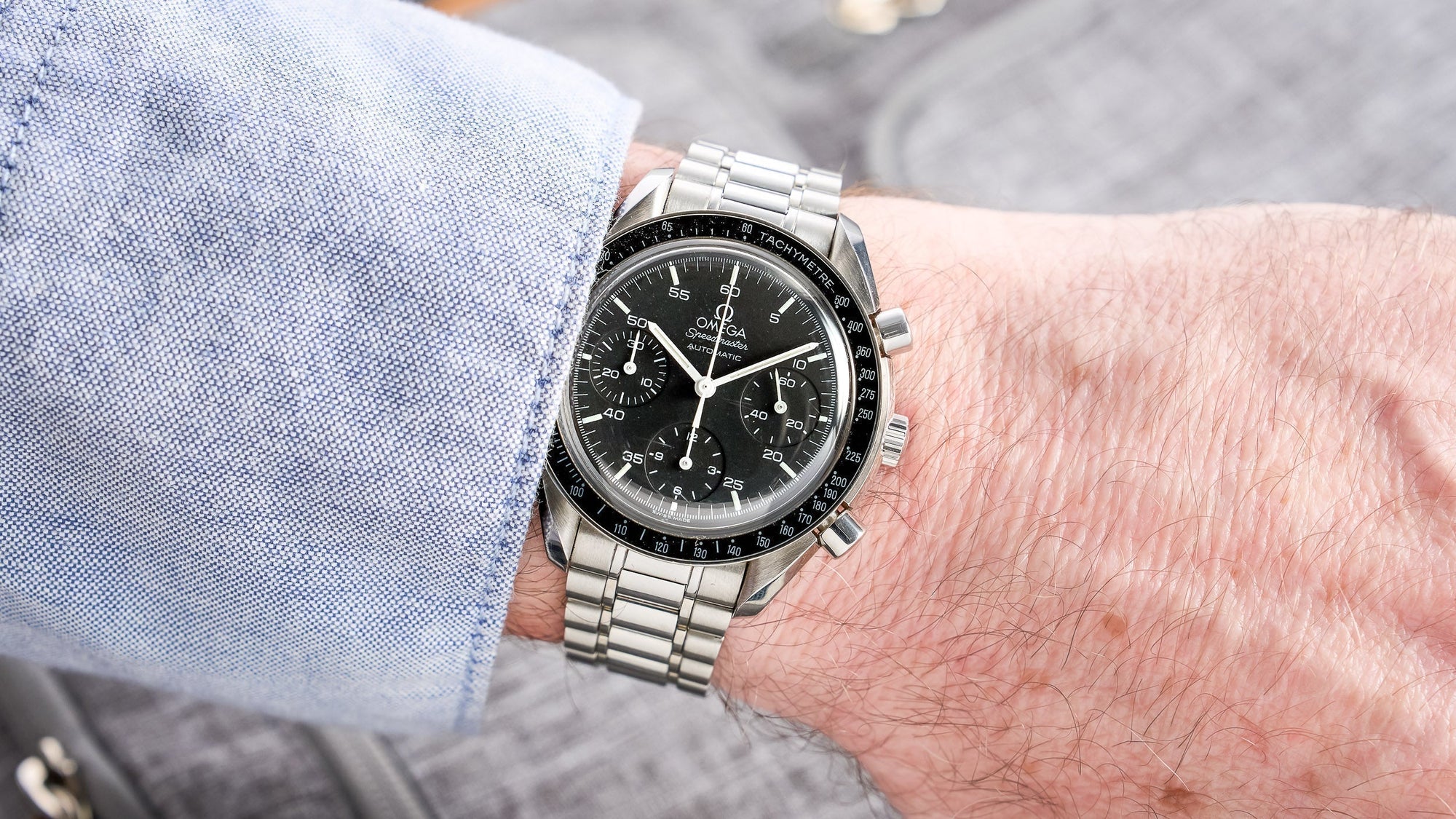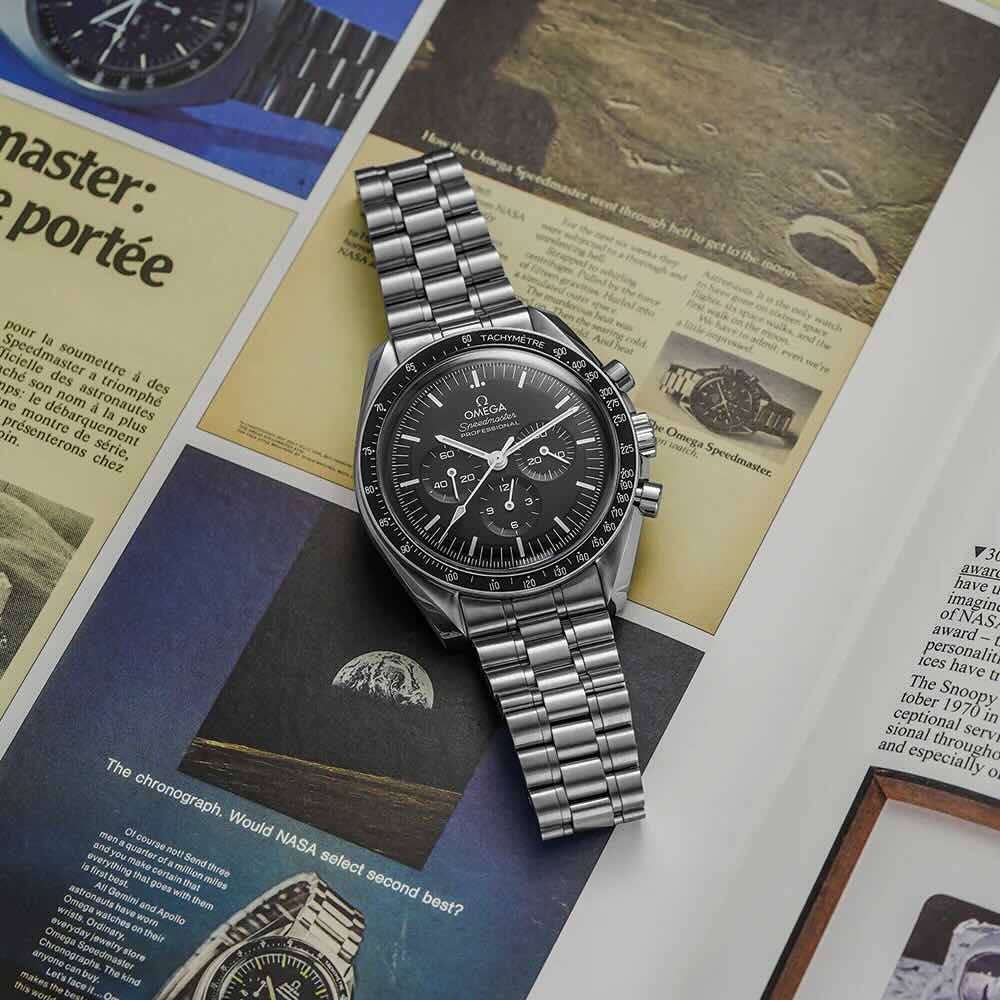The Omega Speedmaster Reduced was released back in 1988, intended as a smaller and more affordable cousin of the Speedmaster Professional. The Speedmaster Reduced shares most of the same design codes as the Moonwatch but it is undoubtedly one of the more divisive watches out there, especially for those Speedy purists who see it as an imposter that should never have been manufactured. I would imagine that sales were fairly robust, considering how many of these are available on the secondary market and the fact that it was produced from 1988 all the way to 2009.
Speedmaster Reduced Case & Bracelet

Considering this is called the Speedmaster Reduced, it should be no surprise that the case is indeed smaller than the 42mm Speedmaster Professional (which we did a comprehensive guide to here). Done in stainless steel measuring 39mm wide and 12mm thick with a very compact lug-to-lug height of 45mm compared to the Speedy Pro’s 47.5mm. One of the funny tradeoffs that you get from using an automatic movement instead of a manually wound one is a thicker case, so even with the reduced case size, the 12mm thickness is only about a millimeter slimmer than the Pro. Still, the compact proportions make for an easier wear for those with smaller wrists. The Speedmaster Reduced has 30 meters of water resistance, which is shy of the 50 meters of the Speedy Pro, but I think both require quite a bit of caution with anything more than a splash.

The familiar tachymeter bezel is done in aluminum, which does indeed attract some scratches but, hey, it adds character! I do find it curious that while almost every Speedmaster Professional reads “TACHYMÈTRE” on the bezel, the Reduced reads “TACHYMETRE” without the accent mark on the first “e.” Anyway, what may not add character, however, are the slightly awkward pushers. When looking at the case profile on the crown side, you’ll notice that the pushers aren’t at the same level as the crown. This is due to the modular chronograph movement (which I’ll get into later) and wouldn’t be an issue with an integrated chronograph. That said, while it looks a little awkward, there is something of an added benefit from the higher pushers not pushing into one’s wrist. I know it’s a matter of taste, but people really make a huge deal out of the crown and pushers not being on the same level. Frankly, I really don’t think it’s the end of the world. In fact, I kind of dig the wabi-sabi.

I am constantly ranting and raving about how more watches with just “okay” movements should embrace enclosed casebacks and the Speedy Reduced is a great example of why. Obviously, this watch was never going to get an exhibition caseback considering the Speedmaster Professional’s enclosed caseback, but the simple hippocampus engraving looks great and ties the whole thing back to the Pro very nicely. This iteration of the Speedmaster Reduced that ran from 1988-2010 has a hesalite crystal while the short-lived follow up made the upgrade to sapphire. Personally, I love a hesalite crystal and enjoy that classic domed aesthetic that we see here.

Finally, there is the bracelet, which measures 18mm wide at the lugs. Let’s be honest and admit that this is a bracelet that is showing its age with the stamped clasp and an overall “jingly” feeling. That said, the finishes are pretty nice, with brushed outer links and polished center links.
Omega Speedmaster Reduced Dial

One of, if not the single, biggest selling points of the Speedmaster Reduced was the close resemblance the watch has to its older sibling. The monochromatic, matte-black-and-white dial certainly does an excellent job of that and legibility here is excellent as a result. That said, this is not a replica of the Speedmaster Professional dial done on a smaller canvass. While there is indeed the tricompax layout, the subdials don’t read the same way. In fact, they’re inverted. Where the Moonwatch has seconds at 9 o’clock, hours counter at 6 o’clock and minutes counter at 3 o’clock, the Reduced has the minutes counter at 9 o’clock and seconds counter at 3 o’clock while the hours counter stay at 6 o’clock.

The subdial layout itself isn’t too big of a deal but several people have, quite rightfully, pointed out the fact that their positioning is just a little too far apart and a little too close to the outer edges of the dial. I get why this might bother a lot of people, but my neo-vintage soul can poetically explain away just about any awkward design choice (or necessity as opposed to choice) if it adds some personality. I feel the same way about the five-minute markers around the circumference of the dial. I think it’s adds a sporty touch that just shakes things up from being too much of a “poor man’s Moonwatch.” Finally, while the hour and minutes hands are lumed, the chronograph hand on the Reduced is not.
The Modular Chronograph Movement

If there’s a single point we can tie the “it’s not a real Speedmaster” argument back to, it’s gotta be the movement. The Caliber 3220 is a modified ETA 2890-2 with a Dubois-Dépraz 2020 chronograph module mounted to the dial side of the movement. We’ve already gotten into the uneven leveling of the crown and pushers as well as the flipped running seconds and minutes subdials due to this module. Of course, the motivation behind the creation of the Omega Speedmaster Reduced was three-fold. Yes, it’s smaller and more affordable, but the convenience of an automatic movement was a pretty big deal. I think contemporary buyers are much more open to manual wind movements these days (and let’s be very grateful for that) but a lot of people don’t want to sit there and manually wind their Speedy.
The Caliber 3220 has a decent 40-hour power reserve, as well. I have heard the cost to service some of these modular chronographs can be pretty high (even costing more than the servicing on a Speedmaster Professional) so if you’re in the market for one, you probably want to make sure it’s been serviced somewhat recently.
Schumacher And Other Iterations

Image courtesy of Christie's
The Ref. 3510.50 you see here is the most common Speedmaster Reduced, but it’s by no means the only model that was produced. There were several Schumacher editions done in collaboration with the Formula 1 driver who was an Omega ambassador through the 1990s and early 2000s. I honestly can’t claim that this list is exhaustive but it should be close: the Ref. 3510.81 was a blue-dial model with white and red accents; the Ref. 3510.80 was also a blue dial model but with a “Cart” logo at 6 o’clock; the 3810.61.41 had a Ferrari red dial with yellow chronograph hands; the 3520.12 had a yellow dial with red chronograph hands; the 3517.30 had a very cool, almost off-white dial with a checkered pattern and “RACING” written over the 6 o’clock subdial; and the 3518.50 is the black-dial model with an orange and red outer ring. Pricing for these can vary quite a bit depending on the version and condition, but they typically start around $2,300 and go up to $6,000.
As for the non-Schumacher versions, there were several made with varying use of gold. For example, some of the priciest Speedmaster Reduced models are the Ref. 175.0032 and 175.0033, which have a gold case and either champagne or two-tone champagne- and-black dial. There were also several JDM models which happen to be some of the best-looking, as well: for example the 3510.2 and 3510.82 which were made for the department store Marui. Frankly, there are tons of Speedmaster Reduced models out there with vastly varying provenance, so I can only recommend doing your homework and thorough due diligence with these.
Final Thoughts

The Omega Speedmaster Reduced is not the only automatic or even smaller-cased Speedmaster produced by Omega. In fact, the Speedmaster 38mm is still in production to this day although it is now marketed more as a ladies watch rather than unisex (which is how I’d prefer it). And there is also the Speedmaster Racing which some people prefer to the Reduced. What makes the Speedmaster Reduced unique, however, is the fact that Omega made it look as much like the Speedmaster Professional as possible rather than a distant relative. Watch enthusiasts like you and I might easily be able to distinguish a Reduced from a Moonwatch, but I doubt the casual observer could.

While I would love for Omega to revive the Speedmaster Reduced, I doubt that is going to happen in the near future. Fortunately there is no shortage of these Speedmaster Reduced watches out there, starting in price around $2,000 and going up from there. Again, this is a watch you want to do your homework on and make sure you’re getting the real thing that, ideally, has a servicing history.
























































0 Comments